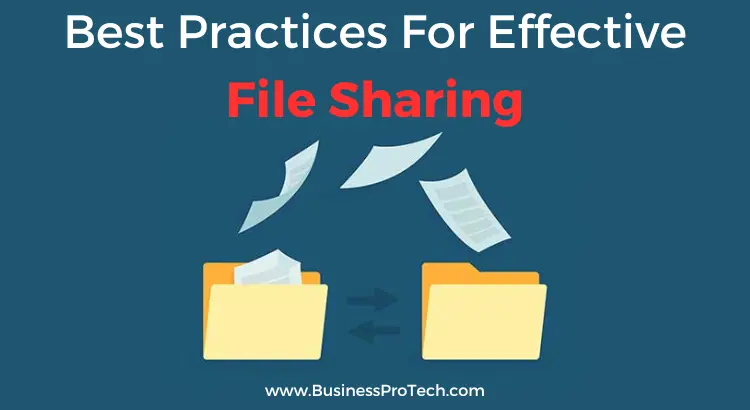File sharing has become an integral part of the modern workplace. It allows teams to collaborate on projects and share documents and data quickly and efficiently. That said, knowing the best practices can allow you to maximize their benefits.
Whether using cloud storage services or traditional methods like file transfer protocol (FTP), secure file sharing is essential for many businesses and organizations. This entails maintaining confidentiality, protecting intellectual property, and providing a secure data transfer environment.
That said, here are some best practices you can implement to ensure the security of your files when shared with others:

Invest in a Robust File-Sharing Method
Choosing a secure and convenient file-sharing method is the first step to ensuring an effective file-sharing process and efficient collaboration within your organization. Generally, email, cloud storage services, and peer-to-peer networks are the most common file-sharing methods.
Email is easy to send small files quickly, but third parties can intercept emails or be lost in transit due to server problems. Additionally, email programs usually limit the size of attachments you can send. On the other hand, cloud storage services offer more security than email but pose risks if not correctly configured with strong passwords and encryption protocols.
Lastly, peer-to-peer networks provide fast speeds for transferring large amounts of data. Moreover, you can easily monitor file transfers, follow the syntax command, and check rsync progress.
The key to an efficient file-sharing process is identifying your business’s needs. As a good start, your organization’s priorities should include security protocols, storage capacity, transfer speeds, user access levels, and integration with other systems when choosing which file-sharing method to use.
Make a Clear File Structure
Once a secure file-sharing method has been chosen, the next step is to create a clear file structure. This can help keep files organized and easily accessible for users who need them. When setting up this system, the first thing to consider is what type of structure works best for your organization. Generally speaking, there are two main types: hierarchical and flat.
Hierarchical Folder Structure

This structure is similar in concept to how folders are arranged on a computer desktop. It consists of different levels and sub-levels that can store documents according to their purpose or by the respective departments.
A hierarchical folder structure can help keep files organized and lets users quickly find the necessary information. Moreover, permissions can be assigned so only those with access can view specific folders, preventing unauthorized personnel from seeing sensitive data.
Flat Folder Structure
With this structure, organizations store all documents in one extensive collection without hierarchy or order. While this may seem easier initially, as it doesn’t require making complex decisions about where things should go, it can quickly become overwhelming if too many files accumulate over time and make searching through them difficult.

Ultimately, both methods have pros and cons depending upon the organization’s size and how often they plan on using their shared files, so it’s essential to evaluate these factors carefully before deciding which approach works best for you.
Control Access Privileges
To protect sensitive information, regulating who has access to data and what they can do with it is essential. This includes both internal personnel and external contacts like consultants or contractors.
Here are four ways organizations can improve their file-sharing practices:
- Define user roles: Organizations must identify which individuals have access rights to specific files or folders. Only those authorized should be able to view, edit, share, or delete content.
- Set up authentication protocols: Establish secure authentication methods that allow only verified users into the system, such as two-factor or multi-factor authentication.
- Implement monitoring tools: Companies must monitor usage patterns to detect potential cybersecurity threats, such as unauthorized downloads or suspicious uploads from outside sources.
- Ensure remote device safety: As more employees work remotely, companies must ensure that all devices used for file-sharing are equipped with necessary security measures like encryption technology and password protection systems.
In addition, organizations should create policies around acceptable use so everyone knows how best to handle confidential information stored on shared networks and devices.
Audit and Organize Existing Data
Organizing existing data is also a critical step in effective file sharing. By auditing your current files and folders, you can identify redundant, outdated, or unnecessary documents that should be deleted.
This can also make finding the essential files easier when needed. It’s also a good idea to create subfolders within more significant categories of information for better organization.
Another way to review existing data is to assess whether or not any changes need to be made. If there are inaccuracies or discrepancies between versions, they should be corrected as soon as possible so everyone can access the same up-to-date version of each document.
Consider updating old formats with more modern ones that are easier to share with multiple people.
Set Expiration For Shared Links
While sending links can be a great way to share large files, it’s best practice to set them to expire for data security purposes, especially if you’re sharing them outside the organization. After a certain amount of time has passed or after so many clicks on the link, set it to expire automatically so that no one else can access your data once the recipient finishes accessing or using it.
However, if employees or external parties need more time, you can give them access for a specified time instead of granting permanent access to them and then revoking it after the time elapses.
Final Words
Effective file sharing is critical for any business since it promotes productivity, better internal collaboration between team members, and coordination with external parties like consultants. That said, it’s important to understand the best practices mentioned above to ensure your data’s security and maximize efficiency.
By following these guidelines, you can set up an efficient and secure file-sharing system for your organization. Remember that when it comes to protecting sensitive documents, there’s no room for error. With the right processes, your team can work together to ensure your business’s digital assets remain safe and sound.